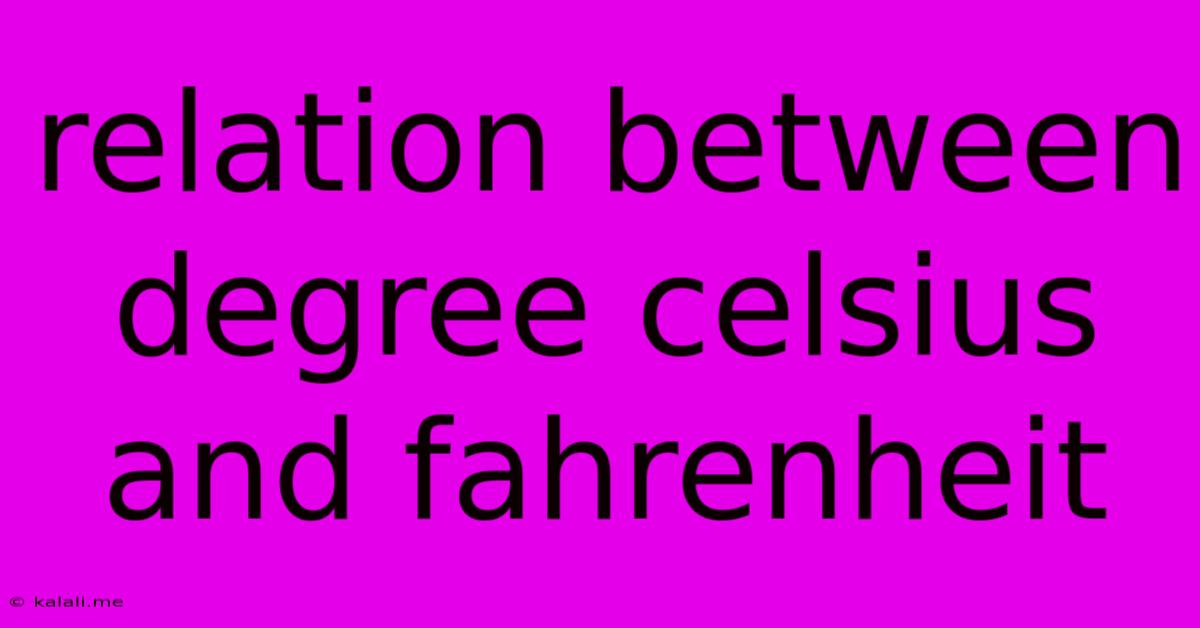Relation Between Degree Celsius And Fahrenheit
Kalali
Jun 13, 2025 · 2 min read

Table of Contents
Understanding the Relationship Between Celsius and Fahrenheit
Ever wondered how to convert temperatures between Celsius and Fahrenheit? These two scales are the most commonly used temperature scales worldwide, yet they differ significantly in their reference points. This article will delve into the relationship between Celsius and Fahrenheit, explaining the conversion formulas and providing examples to help you master temperature conversions. Understanding this relationship is crucial for various applications, from everyday life to scientific research.
The Core Difference: Freezing and Boiling Points
The fundamental difference lies in the defining points of water. The Celsius scale (°C) sets the freezing point of water at 0°C and the boiling point at 100°C, creating a 100-degree interval. The Fahrenheit scale (°F), on the other hand, sets the freezing point of water at 32°F and the boiling point at 212°F, resulting in a 180-degree interval. This difference in intervals is key to understanding the conversion process.
Conversion Formulas: From Celsius to Fahrenheit and Vice Versa
Fortunately, converting between these scales is straightforward thanks to established formulas:
1. Celsius to Fahrenheit:
The formula to convert Celsius (°C) to Fahrenheit (°F) is:
°F = (°C × 9/5) + 32
This formula takes the Celsius temperature, multiplies it by 9/5 (to account for the difference in intervals), and then adds 32 (to adjust for the different freezing point).
2. Fahrenheit to Celsius:
Conversely, to convert Fahrenheit (°F) to Celsius (°C), use this formula:
°C = (°F - 32) × 5/9
Here, we first subtract 32 (to account for the different freezing point) and then multiply by 5/9 (to adjust for the different intervals).
Examples to Illustrate the Conversions
Let's look at some practical examples to solidify your understanding:
Example 1: Converting 25°C to Fahrenheit
Using the formula: °F = (°C × 9/5) + 32
°F = (25 × 9/5) + 32 = 45 + 32 = 77°F
Therefore, 25°C is equivalent to 77°F.
Example 2: Converting 68°F to Celsius
Using the formula: °C = (°F - 32) × 5/9
°C = (68 - 32) × 5/9 = 36 × 5/9 = 20°C
Therefore, 68°F is equivalent to 20°C.
Beyond the Formulas: Understanding the Underlying Principles
While the formulas are essential for accurate conversion, understanding the underlying principles—the different reference points and the resulting interval differences—is crucial for a deeper grasp of the relationship between Celsius and Fahrenheit. This understanding allows for more intuitive estimations and a better appreciation of temperature scales in various contexts. This knowledge is valuable for anyone working with temperature measurements, from chefs adjusting oven temperatures to scientists conducting experiments. Remember, accuracy is paramount, especially in scientific applications, so always use the correct formulas for precise conversions.
Latest Posts
Latest Posts
-
What Does The Area Under The Velocity Time Graph Represent
Jun 14, 2025
-
Which Of The Following Is An Irrational Number
Jun 14, 2025
-
Which Of The Following Statements About Activity Based Costing Is True
Jun 14, 2025
-
Caring For A Client Who Has Paraplegia
Jun 14, 2025
-
The More Diverse And Wide Ranging
Jun 14, 2025
Related Post
Thank you for visiting our website which covers about Relation Between Degree Celsius And Fahrenheit . We hope the information provided has been useful to you. Feel free to contact us if you have any questions or need further assistance. See you next time and don't miss to bookmark.